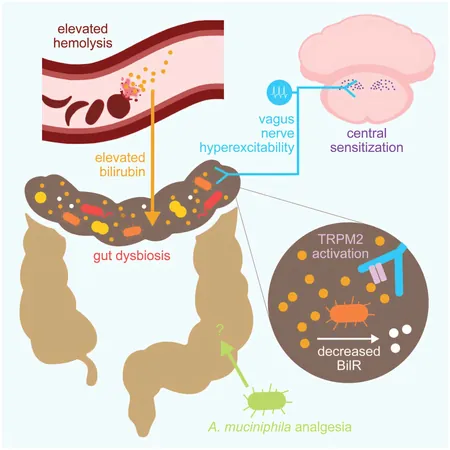
Breakthrough Study Links Gut Bacteria to Chronic Sickle Cell Pain
2025-09-22
Author: John Tan
Revolutionary Link Between Gut Microbiome and Sickle Cell Pain
Recent research from The University of Texas at Dallas unveils a groundbreaking connection between chronic pain in sickle cell disease and the bacteria residing in our guts. Spearheaded by Dr. Katelyn Sadler, an assistant professor of neuroscience, the study could pave the way for new treatment protocols for those suffering from this debilitating condition.
Meet the Beneficial Bacterium: Akkermansia muciniphila
Focusing on the bacterium Akkermansia muciniphila, typically found in healthy human guts but surprisingly absent in many sickle cell patients, the research team transplanted microbes from healthy mice into sickle cell-afflicted mice. The results were staggering: this simple intervention significantly reduced chronic pain.
Dr. Sadler asserts, "Our findings strongly support that the microbiome's makeup in individuals with sickle cell can influence chronic pain severity." This revelation not only shines a light on the complexities of the disease but also hints at innovative solutions.
Understanding Sickle Cell Disease: More Than Just Pain
Sickle cell disease is a genetic disorder characterized by irregularly shaped red blood cells that block blood flow and lead to sudden, intense pain episodes. Compounding the issue, an estimated 50% of those affected endure chronic pain that isn't fully understood. Sadler emphasizes that the dynamics between the gut microbiome and chronic pain are just emerging but hold significant promise in treatment strategies.
The Surprising Role of Gut Bacteria
"The bacteria in your gut can dramatically affect how your immune system reacts, influencing pain perception in various parts of your body," Dr. Sadler explains. This burgeoning area of research aligns with findings related to conditions like fibromyalgia, suggesting that gut health might be critical to managing pain.
The Promise of Probiotics
Interestingly, Akkermansia muciniphila is available as a probiotic supplement, opening potential avenues for therapeutic use in sickle cell patients. The study marks a significant first step in identifying this specific bacterium as a potential target for alleviating sickle cell-related pain.
Translating Findings into Therapy
Notably, transplants from sickle cell mice to healthy ones transferred not the disease itself but the hypersensitivity to pain stimuli. This indicates a profound influence of gut bacteria on pain perception. Central sensitization, a condition where the nervous system goes into overdrive, appears to be a key mechanism at play.
A New Era for Pain Management?
Dr. Amanda Brandow, leading author of the study and a pediatric hematologist, stresses the significant impact of chronic pain on life quality for sickle cell patients. This research opens doors for clinical trials focusing on probiotics or fecal microbiota transplantation—potentially life-changing treatments that could be both effective and affordable.
Dr. Sadler refers to these discoveries as groundbreaking, stating, "Current management options for chronic sickle cell pain are limited and often costly. This breakthrough offers hope for a new, less invasive path forward that has not been thoroughly explored before."
The Future is Bright: Growing Solutions
With rigorous methodologies, the study also highlights how the necessary bacteria were cultivated in controlled environments, showcasing the innovative approaches researchers are taking. As scientists continue to explore the gut-brain connection, patients with sickle cell disease could soon have exciting new treatment options on the horizon.



 Brasil (PT)
Brasil (PT)
 Canada (EN)
Canada (EN)
 Chile (ES)
Chile (ES)
 Česko (CS)
Česko (CS)
 대한민국 (KO)
대한민국 (KO)
 España (ES)
España (ES)
 France (FR)
France (FR)
 Hong Kong (EN)
Hong Kong (EN)
 Italia (IT)
Italia (IT)
 日本 (JA)
日本 (JA)
 Magyarország (HU)
Magyarország (HU)
 Norge (NO)
Norge (NO)
 Polska (PL)
Polska (PL)
 Schweiz (DE)
Schweiz (DE)
 Singapore (EN)
Singapore (EN)
 Sverige (SV)
Sverige (SV)
 Suomi (FI)
Suomi (FI)
 Türkiye (TR)
Türkiye (TR)
 الإمارات العربية المتحدة (AR)
الإمارات العربية المتحدة (AR)